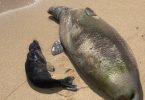When African ministers and experts are meeting today in Botswana to
chart out strategies to save the African elephant, Tanzania and other
range states are facing daunted challenges in anti-poaching campaigns.
The three-day meeting opened in Botswana’s capital of Gaborone has
been organized by the Botswana government and the International Union
for Conservation of Nature (IUCN).
Poaching has escalated at an alarming rate in Africa during the past
20 years, threatening disappearance of African jumbos, increased in
recent years.
“Poaching of elephants and associated ivory trafficking remain of
grave concern,” said Richard Thomas, spokesman for the animal
conservation group, Traffic.
IUCN said increasing poaching levels and loss of habitat are
threatening the survival of elephants in central Africa as well as in
previously secure havens in west, southern and east Africa while the
price of ivory on the black market increased tenfold to more than
$2,000 per kilogram.
Elephant tusks are used to make ornaments and rhinoceros horns are
used in traditional medicine in Thailand and Taiwan.
Elephant killings fuelled by a growing demand for ivory in Asia. The
Most of the ivory ends up in the Middle East and Asia, particularly in
Thailand and China. The tusk of an adult 30-year-old African elephant
can weigh around 20 kilograms (44 pounds), according to experts.
The Gaborone meeting has come at the time when African elephant range
states are looking at the best steps to curb escalating poaching of
jumbos and the rhino, while militarized anti-poaching campaigns have
been designed in Tanzania and Kenya, two among leading African range
states.
Tanzania has been identified as the leading exporter of illegal ivory
in recent years. An estimated 10,000 elephants are being slaughtered
in the country annually.
IUCN said about 30,000 elephants are slaughtered in Tanzania every
year, quoting data provided by the Tanzania Wildlife Research
Institute.
Tanzanian Minister for Natural resource and Tourism Khamis Kagasheki
said poaching situation in this African country shows that the
remaining elephants are in danger to total extinction.
Poachers in Tanzania now use advanced and sophisticated weapons
including silence automatic rifles with telescopes to kill elephants.
While poachers are organizing themselves, Tanzanian government has not
designed mechanism which could apply modern technology, public
awareness campaigns and intelligence methods to combat poaching in
national parks and game reserves.
Politics and speeches have been the only weapon which the Tanzanian
government has invested to run anti-poaching campaign. The
just-launched anti-poaching operation dubbed “Termination” failed to
take a serious course because of politics through the Tanzanian
parliament.
Wildlife conservation experts in this country have advised the
government to apply modern science and technology in conserving wild
animals, particularly the endangered species.
They said the poor technology had given the poachers a room to kill
elephants smoothly.
Tanzania’s elephant population declined from 109,000 elephants in 2009
to the current estimate of less than 70,000 elephants in 2012. That
is at a rate of more than 10,000 elephants a year.
Estimates are that currently, 30 elephants are killed per day or
10,950 elephants will be killed in 2013. If this slaughter is allowed
to continue unabated, the last of our elephants will be killed in
seven years time, the year 2020, according to wildlife experts.
Tanzania, one of the world’s last great repositories of elephants has
about 70,000 to 80,000 elephants roaming this nation’s 37 game
reserves, leaving alone those in protected national parks. Tanzania
has about a quarter of all African elephants.
Poaching of elephants has a long history in Tanzania between 18th and
19th centuries when Arab merchants and slave trade masters hunted
elephants for tusks sold to the Middle East through Oman.
Since then, Tanzania’s island of Zanzibar held the largest ivory
auctions in the world. Today Tanzania has regained that infamy. Those
public auctions have been replaced by underground networks of
smugglers, but Tanzania remains a leading source of bloody ivory in
East Africa.
Addressing the parliament of Tanzania last month, Tanzanian president
Mr. Jakaya Kikwete had expressed his concern over poaching of
elephants and rhinos in this African country, warning the poachers of
a tough action.
Mr. Kikwete said poaching of elephants and rhinos in Tanzania and
Africa had increased to an alarming rate, threatening extinction of
those big mammals from the face of this continent.
Between September and early this month, Mr. Kikwete had ordered
security operatives including the armed forced to conduct
anti-poaching operation in all areas of Tanzania suspected to harbor
poachers and stakeholders in bloody ivory trade.






















